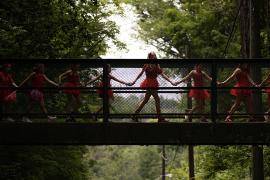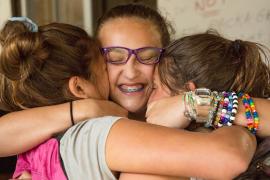The camp lady of Chicago showed me photos of swank camps with luxurious cabins, electric tennis ball cannons, and soft-serve ice-cream machines. She talked up theatre and sports camps. She effused enthusiasm for all the currently “in” camps. No sale.
Finally she mentioned Camp Kamaji, Minnesota’s oldest camp for girls. Tight-lipped, she described ramshackle cabins. She admitted it was under new ownership, not yet accredited by ACA, and very, “and I mean very,” rustic. No electricity, no heat, and no toilets.
She hadn’t really thought I’d bite. Who chose outhouses over ice-cream machines?
I did.
To her I was an oddity, but for me the choice was clear. As it turned out, I picked well. This dilapidated camp, situated 210 miles north of Minneapolis, would become more than a place where I’d learn to build a fire or shoot an arrow. It would become the place where I’d leave my familial conflicts behind and be my most joyful.
Several months and two duffle bags later, I arrived alongside forty other girls for a four-week stay. It was the summer of 1981. I was almost ten years old. As I stepped off the bus, pine needles fluttered downwards mimicking the sensation in my stomach.
In minutes, I’d be whisked off to the Nutshell, home to the youngest campers, where I’d make my bed and locate my flashlight. Soon camp would be enveloped in a calm, thick darkness.
True to the camp lady’s word, Kamaji was rustic. We brushed our teeth with ice-cold water over a trough with spigots, watching our collective backwash slide past. We used outhouses. There was no heat in the cabins, and the mosquitoes were relentless. Yet it hardly felt like hardship; rather a welcome respite from real life.
For such a young camper, I’d arrived with quite a lot of baggage — and I don’t mean the duffles. My parents separated when I was two. My father was diagnosed with cancer when I was three. He died before I was four. My mother worked and raised me alone until she met and married a widower with two children. I was eight and suddenly part of a merged family. There were three of them and two of us. I was an outsider in my own home.
At Kamaji, I met Sara from Oklahoma and Susie from Kansas. Over the years these girls would provide invaluable support and a sense of belonging. Sara explains it well: “If I had a bad day with my friends at school, I could rely on the knowledge that I had these other friends.” It was like having the security of invisible friends, only better — they were real.
Beyond the emotional support came the extraordinary experience of befriending someone who was different, yet the same. I was the first Jew either Susie or Sara had ever known, but I wouldn’t be the last. The new directors, Mike and Kathy Jay, were an interfaith couple committed to building a spiritually, ethnically, and socio-economically mixed clientele.
While atypical, enduring friendships were the primary reason we returned every summer, there were other draws, too. We came back to camp because we had more autonomy. Because popularity was diluted. Because we had a break from the boy-crazed competition of adolescence. Because it was a Secret Garden, a Taribithia, a magical separate place. Because, as Sara says, “We weren’t necessarily our different selves at camp. Possibly just our truer selves.”
Our reasons for returning had nothing to do with infrastructure. Camp was a fixer-upper when Mike and Kathy took control. There were rumors the prior owners were financially distressed. Attendance had declined precipitously.
Kamaji had been beaten down, but its essence was in tact. The songs and traditions collected over generations had endured. The backdrop of lake against trees and trees against sky was unwavering.
Strategic improvements happened over time. Outhouses were razed. Showers and bathrooms were built. Accreditation was achieved. Attendance boomed to 150 girls.
Over the ten summers I spent at Kamaji, both as camper and counselor, camp blossomed, and so did I. During that time, I’d gone from fragile, misplaced kid to confident, college graduate.
In 1993, Sara, Susie, and I each enlisted friends from home to work as counselors alongside us. My need to separate camp and home had disappeared. It was my final, sweet summer at camp. By then, Kamaji had become an “in” camp among parents and girls from Chicago. I applauded this success, yet I knew my ten-year-old self would have balked at going to such a well-known camp. Back in the camp lady’s office, I’d found the idyllic spot for me, where no one had a preconceived notion of who I was or what I’d experienced.
Kamaji and I had crossed paths at the perfect point in time; it was down and “out” — on the edge of obscurity, exactly when I’d needed it to be.
Susan Szafir is an author and freelance writer residing in the Pacific Northwest, who dreams of someday sending her two young daughters to Camp Kamaji for Girls. Contact the author atsusan@susanszafir.com.
Originally published in the 2012 March/April Camping Magazine.



